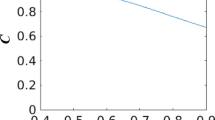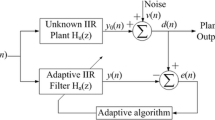Abstract
In view of characteristics of particle swarm optimization (PSO) algorithm of fast convergence but easily falling into local optimum value, a novel improved particle swarm optimization algorithm is put forward, and it is applicable to identify parameters of hydraulic pressure system model in strip rolling process. In order to maintain population diversity and enhance global optimization capability, the algorithm is firstly improved by means of decreasing its inertia weight linearly from the maximum to the minimum and then combined with chaotic characteristics of ergodicity, randomness and sensitivity to initial value. When the improved algorithm is used to identify parameters of hydraulic pressure system, the comparison of simulation curves and measured curves indicates that the identification results are reliable and close to actual situation. A new method was provided for hydraulic AGC system model identification.
Similar content being viewed by others
References
WANG Yi-qun, WANG Hai-fang, GAO Ying-jie. Neural Network Based Adaptive Identification for Hydraulic AGC System in Strip Mill [J]. China Mechanical Engineering, 2004, 15(5): 450 (in Chinese).
KE Jing, QIAN Ji-xin, QIAO Yi-zheng. A Modified Particle Swarm Optimization Algorithm [J]. Journal of Circuits and Systems, 2003, 8(5): 87 (in Chinese).
YAO Jun-feng, MEI Zhi, PENG Xiao-qi. A New Optimization Approach-Chaos Genetic Algorithm [J]. Systems Engineering, 2001, 19(1): 70 (in Chinese).
QIU Li-qiong. Dynamic Simulation for Hydraulic Pressure AGC of Rolling Mill [J]. Journal of Chongqing University, 2001, 24 (2): 28 (in Chinese).
Clerc M, Kenedy J. The Particle Swarm Explosion, Stability and Convergence in a Multidimensional Complex Space [C] // IEEE International Conference on Evolutionary Computation. Piscataway: IEEE Press, 2002: 58.
WANG Ling. Application of Two Intelligent Optimum Algorithms [M]. Beijing: Tsinghua University Press, 2001 (in Chinese).
YANG Hui-xian, LIU Zi-wen, WANG Jun. Modified PSO Hybrid Algorithm [J]. Journal of Computer Applications, 2010, 30(6): 1516 (in Chinese).
CHEN Ru-qing, YU Jin-shou. Study and Application of Chaos-Particle Swarm Optimization-Based Hybrid Optimization Algorithm [J]. Journal of System Simulation, 2008, 20(6): 685 (in Chinese).
GAO Shang, YANG Jing-yu. Research on Chaos Particle Swarm Optimization Algorithm [J]. Pattern Recognition and Artificial Intelligence, 2006, 19(2): 266 (in Chinese).
LIU Wei, LIU Peng, DOU Qian. Application of PSO for Parameter Identification of Exciting System Based on Measured Data [J]. Guangxi Electric Power, 2009(1): 37 (in Chinese).
FANG Chon-zhi, XIAO De-yun. Process Identification [M]. Beijing: Tsinghua University Press, 1988 (in Chinese).
Author information
Authors and Affiliations
Corresponding author
Additional information
Foundation Item: Item Sponsored by National Natural Science Foundation of China (51075352)
Rights and permissions
About this article
Cite this article
Yu, Yz., Ren, Xy., Du, Fs. et al. Application of Improved PSO Algorithm in Hydraulic Pressing System Identification. J. Iron Steel Res. Int. 19, 29–35 (2012). https://doi.org/10.1016/S1006-706X(13)60005-9
Received:
Published:
Issue Date:
DOI: https://doi.org/10.1016/S1006-706X(13)60005-9




